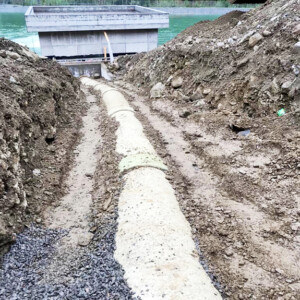Tischbach supplies 120 households with green energy from thus far untapped energy potential
In July 2020, roughly nine months after the start of construction in the Canton of Graubünden, Albula Landwasser Kraftwerke‘s (ALK) Tischbach small hydroelectric power plant has commenced regular operations. Thanks to the new construction, a previously unused hydro-energetic supply line between the Tischbach water catchment to the Bergün balancing reservoir is now employed for the generation of clean power. As part of the necessary innovation of the damaged supply line, the plant‘s power house could be built with minimal temporary interference in the landscape. The complete electromechanical equipment, whose core is a durable crossflow turbine with a maximum installed output of 238 kW, was supplied by Ossberger, a German expert in small-scale hydroelectric power plants.
Founded in the 1960s, Graubünden-based Albula Landwasser Kraftwerke AG (ALK) operates two hydroelectric power plants, Filisur and Tiefencastel. 75 percent of ALK‘s company shares are owned by the Swiss power company AXPO, 15.74 percent are held by EWD power plant Davos AG, 5 percent by the Canton of Graubünden, and the remaining 4.26 percent are shared by the local municipalities Albula/Alvra, Bergün, Filisur and Schmitten. The Filisur power plant, which was completed in 1967 (water catchments from Albula and Landwasser and a central feed water system) employs two vertical shaft Francis turbines to generate power, with a bottleneck capacity of 32.5 MW each; in normal years, the plant generates roughly 286 GWh of green energy. In 1989, ALK started operating the downstream power plant Tiefencastel. Both of its vertical shaft Francis turbines achieve a maximum output of 12 MW each and produce approximately 103 GWh of power in a normal year. In the summer of 2020, the Tischbach small hydroelectric power plant was connected to the grid as the third ALK plant.
UNTAPPED ENERGY POTENTIAL
Felix Hansmann, project lead, details the development history of the Tischbach hydroelectric power plant: ”There is a height difference of approximately 37 m between the Tischbach water catchment that belongs to the Filisur plant, which feeds the Bergün balancing reservoir via a roughly 300 m long feed line, which have thus far not been used for energy. After the approx. 60 year old pipeline had to be replaced due to material wear and corrosion damage, we developed a concept that makes this height difference usable for energy production.” Hansmann further notes that the implementation of the new small power plant became economically feasible thanks to the approval of the Swiss Ökostromtarif (green energy tariff) funds, so-called „feed-in remuneration to cover costs“ (KEV) – new reference: feed-in tariff system (EVS). When EVS funds were granted in the summer of 2019, ALK had already been granted the approval for the replacement of the underground feed pipeline and the construction of the power house in October 2016.
ADJUSTED WATER CATCHMENT
The implementation phase of the project started in May of 2019 with the renewal of the underground feed pipeline between the water catchment and the balancing reservoir. Instead of the DN400 steel pipe, which leaked in multiple areas, a new penstock line by Amiblu was installed in two months with DN700 glass fiber reinforced plastic pipes (GKF). After the approved EVS funding, the construction of the power plant headquarters were started in the following September next to the Bergün balancing reservoir. ”To build the new power plant, the new Tischbach water catchment, which is equipped with a Tyrolean weir intake and a de-sanding basin, only required minor adjustments. The de-sanding basin was equipped with a new transition piece for the enlarged pipe dimensions. In addition, we have installed a steel dividing wall in the de-sanding basin to optimise the normal volume of the water-level controlled turbine”, says Hansmann, who, in addition to holding the project leadership position, is also the head of the construction engineering department.
THE IDEAL SOLUTION: CROSSFLOW
Multiple versions were considered in the selection of the machinery for the new power plant, Hansmann says: ”It became clear relatively quickly that a crossflow turbine is the ideal solution for the Tischbach power plant. Although compared to other machine types, crossflow turbines do not perform at top efficiency, they do cover a wide partial-load range. In addition, crossflow turbines are very durable and can even be reliably operated in case of low water resources – we achieve the nominal flow rate on perhaps ten days of the year.” Ossberger, the internationally renowned German specialist in small-scale hydroelectric power plants won the charge for the construction of the full electromechanical equipment as part of the tender. This provided the core of the plant for a nominal flow rate of 820 l/s and a crossflow turbine designed for a net drop height of 37 m, which achieves a bottleneck capacity of 238 kW. The energy converter of the machine, which is fed horizontally, is a directly connected AEM-brand synchronous generator. The air-chilled 400 V generator was designed for a nominal apparent output of 244 kVA and, like the turbine, rotates at exactly 600 rpm. Ossberger also supplied the medium-voltage switchgear, which was sub-contracted to the South Tyrolean company EN-CO.
CLEAN ENERGY FOR 120 HOUSEHOLDS
The outbreak of the Coronavirus epidemic in the spring of 2020 also affected the completion of the hydroelectric power project, Hansmann explains: ”Although the equipment could be delivered to the construction site in the spring, installation had to be completed by ALK staff due to travel restrictions. Finally, the plant was commissioned by an Ossberger technician in late May.” After four weeks of trial operations in June, the plant could be taken into normal operation in July. Roughly six months after completion, Hansmann draws very positive conclusions about the project: ”Our first operational experiences with the power plant are quite satisfactory, as the machine works immaculately.” In a normal year, the Tischbach power plant generates roughly 550,000 kWh of green energy, which covers the annual power demand of 120 average 4-person households.




